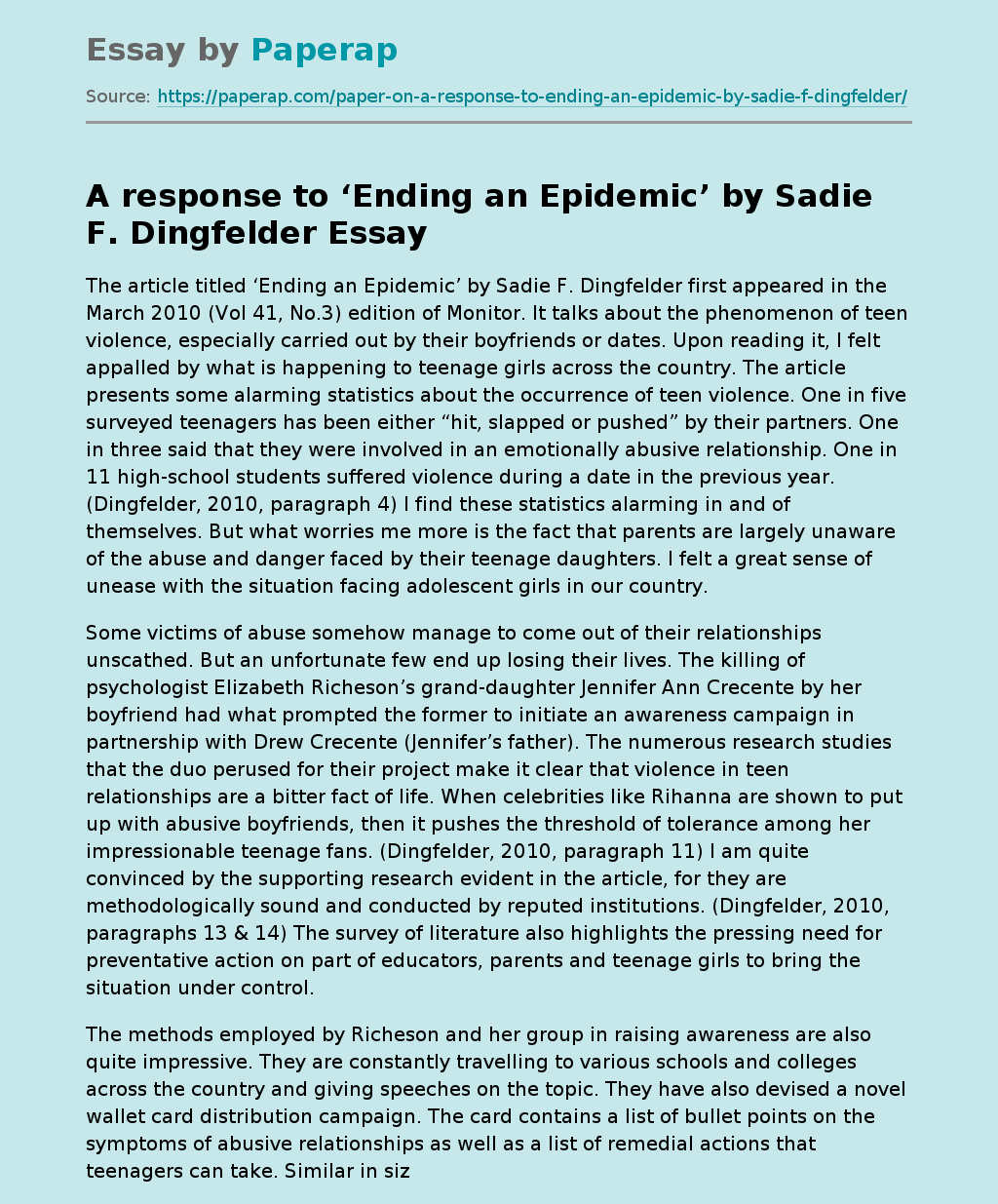A Response to ‘Ending an Epidemic’ by Sadie F. Dingfelder
The article titled ‘Ending an Epidemic’ by Sadie F. Dingfelder first appeared in the March 2010 edition of Monitor. It talks about the phenomenon of teen violence, especially carried out by their boyfriends or dates. Upon reading it, I felt appalled by what is happening to teenage girls across the country. The article presents some alarming statistics about the occurrence of teen violence. One in five surveyed teenagers has been either “hit, slapped or pushed” by their partners. One in three said that they were involved in an emotionally abusive relationship.
One in 11 high-school students suffered violence during a date in the previous year.
I find these statistics alarming in and of themselves. But what worries me more is the fact that parents are largely unaware of the abuse and danger faced by their teenage daughters. I felt a great sense of unease with the situation facing adolescent girls in our country. Some victims of abuse somehow manage to come out of their relationships unscathed.
But an unfortunate few end up losing their lives. The killing of psychologist Elizabeth Richeson’s grand-daughter Jennifer Ann Crecente by her boyfriend had what prompted the former to initiate an awareness campaign in partnership with Drew Crecente.
The numerous research studies that the duo perused for their project make it clear that violence in teen relationships are a bitter fact of life. When celebrities like Rihanna are shown to put up with abusive boyfriends, then it pushes the threshold of tolerance among her impressionable teenage fans.
I am quite convinced by the supporting research evident in the article, for they are methodologically sound and conducted by reputed institutions.
The survey of literature also highlights the pressing need for preventative action on part of educators, parents and teenage girls to bring the situation under control. The methods employed by Richeson and her group in raising awareness are also quite impressive. They are constantly travelling to various schools and colleges across the country and giving speeches on the topic. They have also devised a novel wallet card distribution campaign. The card contains a list of bullet points on the symptoms of abusive relationships as well as a list of remedial actions that teenagers can take. Similar in size to a credit card, the card can be kept discreetly in a purse or a wallet and is a handy reference to troubled teenagers.
I am happy that Richeson and her team are making progress in their campaign (the stream of thankful emails they receive from teenagers and parents is a proof of their success). And I sincerely wish them further success, for, at stake, are the lives of tens of hundreds of innocent and vulnerable teenage girls in our country. What is also at stake is the reputation of our country as a civilized advanced society. It is no consolation to be the most prosperous nation in the world, when we can’t remain assured about the safety of our daughters’ lives and wellbeing. The article titled ‘Ending an Epidemic’ by Sadie F. Dingfelder first appeared in the March 2010 edition of Monitor. It talks about the phenomenon of teen violence, especially carried out by their boyfriends or dates.
Upon reading it, I felt appalled by what is happening to teenage girls across the country. The article presents some alarming statistics about the occurrence of teen violence. One in five surveyed teenagers has been either “hit, slapped or pushed” by their partners. One in three said that they were involved in an emotionally abusive relationship. One in 11 high-school students suffered violence during a date in the previous year. (Dingfelder, 2010, paragraph 4) I find these statistics alarming in and of themselves. But what worries me more is the fact that parents are largely unaware of the abuse and danger faced by their teenage daughters. I felt a great sense of unease with the situation facing adolescent girls in our .
Work Cited
- Sadie F. Dingfelder, Ending an epidemic: Millions of teens are in abusive relationships, and parents are often the last to know.,
- Monitor, March 2010, Vol 41, No. 3, p.32 in print version, retrieved from <http://www.apa.org/monitor/2010/03/epidemic.aspx>
A Response to ‘Ending an Epidemic’ by Sadie F. Dingfelder. (2019, Feb 24). Retrieved from https://paperap.com/paper-on-a-response-to-ending-an-epidemic-by-sadie-f-dingfelder/

